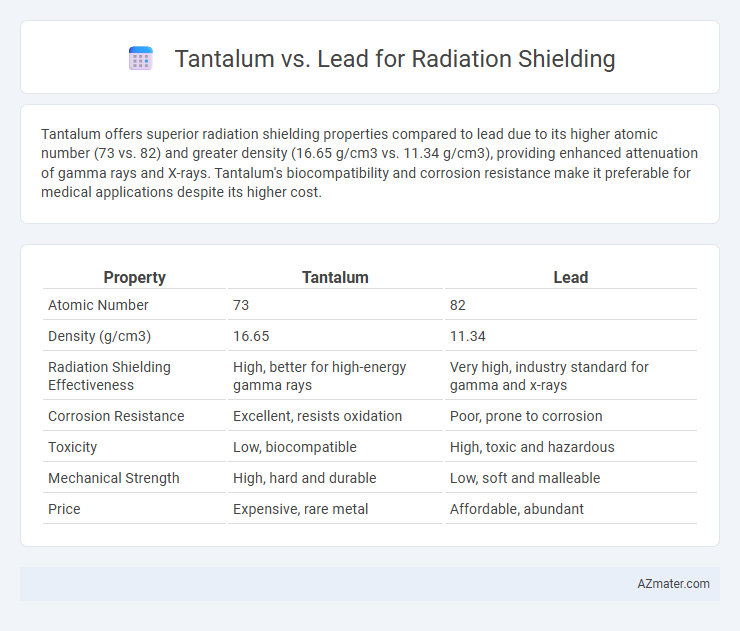Tantalum offers superior radiation shielding properties compared to lead due to its higher atomic number (73 vs. 82) and greater density (16.65 g/cm3 vs. 11.34 g/cm3), providing enhanced attenuation of gamma rays and X-rays. Tantalum's biocompatibility and corrosion resistance make it preferable for medical applications despite its higher cost.
Table of Comparison
| Property | Tantalum | Lead |
|---|---|---|
| Atomic Number | 73 | 82 |
| Density (g/cm3) | 16.65 | 11.34 |
| Radiation Shielding Effectiveness | High, better for high-energy gamma rays | Very high, industry standard for gamma and x-rays |
| Corrosion Resistance | Excellent, resists oxidation | Poor, prone to corrosion |
| Toxicity | Low, biocompatible | High, toxic and hazardous |
| Mechanical Strength | High, hard and durable | Low, soft and malleable |
| Price | Expensive, rare metal | Affordable, abundant |
Introduction to Radiation Shielding Materials
Tantalum and lead are widely used materials for radiation shielding due to their high atomic numbers and densities, which effectively attenuate ionizing radiation. Lead, historically favored for its cost-effectiveness and availability, offers excellent gamma and X-ray shielding but poses environmental and health hazards due to its toxicity. Tantalum, a rarer and more corrosion-resistant metal, provides superior mechanical strength and biocompatibility, making it suitable for specialized applications requiring durable and less hazardous radiation shields.
Overview of Tantalum and Lead
Tantalum is a dense, corrosion-resistant metal with a high atomic number (73), making it highly effective in attenuating gamma rays and X-rays, thus widely used in medical and industrial radiation shielding. Lead, with an atomic number of 82 and superior density, has traditionally been the preferred material for radiation protection due to its excellent absorption of ionizing radiation, cost-effectiveness, and ease of fabrication. Both metals offer distinct advantages: tantalum provides superior chemical stability and mechanical strength, while lead delivers exceptional shielding efficiency at a lower cost.
Physical and Chemical Properties Comparison
Tantalum exhibits a higher density of approximately 16.7 g/cm3 compared to lead's 11.34 g/cm3, offering superior attenuation of gamma radiation due to increased electron density. Chemically, tantalum demonstrates exceptional corrosion resistance and biocompatibility, forming a stable oxide layer that enhances durability in harsh environments, unlike lead which is prone to oxidation and toxicity concerns. These physical and chemical properties make tantalum a preferred choice for long-term, high-performance radiation shielding applications.
Radiation Attenuation Efficiency
Tantalum exhibits superior radiation attenuation efficiency compared to lead due to its higher atomic number (73 vs. 82) and greater density (16.69 g/cm3 vs. 11.34 g/cm3), which enhance its ability to absorb and scatter ionizing radiation. This makes tantalum particularly effective against gamma rays and X-rays, providing enhanced shielding in compact designs where space is limited. While lead remains cost-effective and widely used, tantalum's superior attenuation performance is advantageous in advanced medical and aerospace radiation shielding applications.
Density and Thickness Requirements
Tantalum, with a density of approximately 16.6 g/cm3, offers superior radiation shielding compared to lead, which has a density of about 11.34 g/cm3, allowing for thinner shielding layers to achieve equivalent protection. The higher density of tantalum reduces the required thickness significantly, making it an optimal choice in applications where space and weight constraints are critical. Lead's lower density necessitates thicker panels to attenuate radiation effectively, often resulting in bulkier and heavier shielding solutions.
Durability and Corrosion Resistance
Tantalum demonstrates superior durability and corrosion resistance compared to lead in radiation shielding applications due to its high melting point and strong resistance to chemical attack. Its robustness ensures long-term structural integrity in harsh environments, whereas lead often corrodes and degrades over time under similar conditions. This makes tantalum an ideal choice for radiation barriers where longevity and minimal maintenance are critical.
Health and Environmental Considerations
Tantalum offers superior biocompatibility and lower toxicity compared to lead, reducing health risks during handling and disposal in radiation shielding applications. Lead's widespread use is limited by its classification as a hazardous material due to its neurotoxic effects and environmental persistence, leading to soil and water contamination. The environmental impact of tantalum mining is a consideration, but its inertness and recyclability present a safer, more sustainable alternative for radiation protection.
Cost and Availability Factors
Tantalum offers superior radiation shielding due to its high density and atomic number but is significantly more expensive and less abundant than lead, impacting overall project costs. Lead remains the preferred choice in many applications because of its affordability, widespread availability, and ease of fabrication despite offering slightly lower shielding efficiency. Cost-effectiveness and supply chain stability make lead a practical solution for large-scale radiation shielding needs, while tantalum is reserved for specialized uses demanding enhanced protection.
Industrial and Medical Applications
Tantalum offers superior radiation shielding in industrial and medical applications due to its high atomic number (73) and density (16.69 g/cm3), enabling effective attenuation of gamma rays and X-rays with less material thickness compared to lead. Lead, while more cost-effective and widely used because of its density (11.34 g/cm3) and ease of fabrication, requires thicker layers to achieve similar protection levels, making tantalum preferable in space-constrained environments and advanced medical devices such as CT scanners and radiotherapy equipment. The biocompatibility and corrosion resistance of tantalum also support its use in implantable medical devices and complex industrial shielding structures where long-term durability is critical.
Summary: Choosing Between Tantalum and Lead
Tantalum offers superior radiation shielding efficiency compared to lead due to its higher atomic number and density, providing enhanced protection against gamma rays and X-rays. Lead remains a cost-effective and widely used option with good shielding properties, but it is heavier and more toxic, requiring careful handling and disposal. Selecting between tantalum and lead depends on application-specific factors such as shielding requirements, weight constraints, budget, and environmental considerations.

Infographic: Tantalum vs Lead for Radiation Shielding
 azmater.com
azmater.com